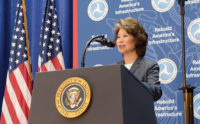
The world didn’t come to an end in 2012, but at least the wait for the re-authorization of the federal transportation funding bill did. Once the $104.4-billion, 27-month Moving Ahead for Progress in the 21st Century Act (MAP-21) was signed by President Obama in July, state transportation agencies could at least solidify capital plans for the next two years. But transportation industry officials bemoaned the fact that even this most non-partisan of issues suffered from one of the most bitterly partisan Congresses in recent history.
That partisanship affected rail and transit, with high-speed rail a constant source of heated debate throughout the year. Even other modes like light rail and commuter rail received a scare in February, when the U.S. House of Representatives proposed slashing dedicated funding as they debated how to shape MAP-21. That threat died down, and California high-speed-rail advocates received a sorely needed boost of hope in the fall as the governor signed a bill to keep the multibillion-dollar effort alive. Major transit rail efforts continue to thrive throughout the country, from Seattle to Denver to Dallas.
 |
Still, transportation infrastructure advocates remained frustrated overall, as they tried diligently to bring the issue into the national spotlight, reminding the public and politicians that investment in infrastructure creates jobs and fixes potentially dangerous bridges and roads. The issue was thoroughly explored in the September bridges issue of ENR’s Critical Infrastructure series.
Bright spots in 2012 included notable projects that allowed for the faster, cheaper and more efficient replacement of bridges, especially using accelerated bridge construction. Utah, Massachussetts and Missouri, among others, all completed impressive programs that use not only construction methods like SPMTs, but project delivery methods like design-build. With public-private partnership projects such as a new toll road, Route 460, and the Houston Loop, Virginia and Texas continued to lead states in transportation project delivery. Kentucky and Ohio are following suit with their P3 and design-build awards for the Ohio River Bridges.
Los Angeles stepped up, embracing design-build, CM-at-risk and the Measure R-infusion of voter-approved funding, which fueled billions of dollars for transit and highway projects. The program did suffer a disappointing blow when Measure J, which would have extended the measure and accelerated projects, lost by a narrow margin at the voting booth in November.
Major airport expansion programs, such as in Miami and Atlanta, taxied into the gate, while others in Dallas, Los Angeles and Philadelphia ramped up. Planners began discussing concepts such as aviation-oriented development. Moreover, we gave extensive coverage to airport and transportation work in Asia, Africa, South America, Europe and the Middle East throughout the year.
The New York Metropolitan Transportation Authority, which dealt with a tragic death from a fallen crane as well as a scary explosion in its massive, $17-billion new construction program, received rare kudos from the public for its handling of the devastation wrought by Superstorm Sandy. The Port Authority of New York & New Jersey made news when it announced that it would expedite the raising of the Bayonne Bridge and embarked on a massive rehabilitation of the George Washington Bridge.
In fact, there were many notable bridge stories in 2012, starting with the selection of Theodore Zoli, bridge engineer, as ENR’s Award of Excellence Winner. Contractors breathed a sigh of relief when the $6-billion Oakland-San Francisco Bay Bridge was lifted off its temporary supports and held its own weight in a self-anchored suspension design. However, the project suffered yet another controversy earlier in the year when allegations surfaced of faulty concrete tests. The $5-billion new Tappan Zee bridge, thanks to a rare surge of political will—in this case, exerted by Gov. Andrew Cuomo—is finally poised to begin the design and construction process, but not before a dramatic, last-minute withdrawal by one of the bidding teams that left many of its members reeling in shock.
This year, ENR also covered one of the most historic projects of the new century, the Panama Canal expansion. Although the main contractor for the third set of locks seems poised to pay liquidated damages for a late completion, the project accomplishments to date are still mind-boggling. The eventual effect on U.S. freight infrastructure will be examined in the final 2012 print issue of ENR.




Post a comment to this article
Report Abusive Comment